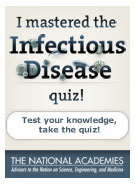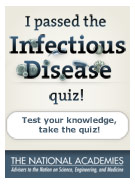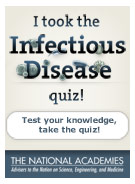
What You Need To Know About Infectious Disease
What do you know about infectious disease?
Which are examples of ways that pathogens (disease-causing microbes) can spread?
- Coughing
- Eating undercooked pork
- Flea bite
- Breathing dust particles containing microorganisms
- All of the above
-
Sorry, that’s incorrect.
All are examples of ways that pathogens can spread. Coughing is an example of airborne droplet transmission; eating undercooked pork is an example of common vehicle transmission; a flea bite is an example of vector transmission; and breathing contaminated dust particles is an example of airborne transmission.
-
Sorry, that’s incorrect.
All are examples of ways that pathogens can spread. Coughing is an example of airborne droplet transmission; eating undercooked pork is an example of common vehicle transmission; a flea bite is an example of vector transmission; and breathing contaminated dust particles is an example of airborne transmission.
-
Sorry, that’s incorrect.
All are examples of ways that pathogens can spread. Coughing is an example of airborne droplet transmission; eating undercooked pork is an example of common vehicle transmission; a flea bite is an example of vector transmission; and breathing contaminated dust particles is an example of airborne transmission.
-
Sorry, that’s incorrect.
All are examples of ways that pathogens can spread. Coughing is an example of airborne droplet transmission; eating undercooked pork is an example of common vehicle transmission; a flea bite is an example of vector transmission; and breathing contaminated dust particles is an example of airborne transmission.
-
Correct!
All are examples of ways that pathogens can spread. Coughing is an example of airborne droplet transmission; eating undercooked pork is an example of common vehicle transmission; a flea bite is an example of vector transmission; and breathing contaminated dust particles is an example of airborne transmission.
For each child who dies from pneumonia in an industrialized country, about how many children die from the infection in developing countries?
-
Sorry, that’s incorrect.
Life-saving vaccines and medications aren’t distributed equitably around the world; for each child who dies from pneumonia in an industrialized country, more than 2,000 children die from the infection in developing countries.
-
Sorry, that’s incorrect.
Life-saving vaccines and medications aren’t distributed equitably around the world; for each child who dies from pneumonia in an industrialized country, more than 2,000 children die from the infection in developing countries.
-
Sorry, that’s incorrect.
Life-saving vaccines and medications aren’t distributed equitably around the world; for each child who dies from pneumonia in an industrialized country, more than 2,000 children die from the infection in developing countries.
-
Correct!
Life-saving vaccines and medications aren’t distributed equitably around the world; for each child who dies from pneumonia in an industrialized country, more than 2,000 children die from the infection in developing countries.
True or False: Most infectious diseases are not impacted by changes in the environment.
-
Sorry, that’s incorrect.
Most infectious diseases are impacted by changes in the environment. Malaria, dengue, and viral encephalitis infections, for example, are highly sensitive to environmental changes.
-
Correct!
Most infectious diseases are impacted by changes in the environment. Malaria, dengue, and viral encephalitis infections, for example, are highly sensitive to environmental changes.
Roughly how many microbes live in the human gastrointestinal tract?
-
Sorry, that’s incorrect.
About ten trillion microbes live in the human gastrointestinal tract. They are essential for proper digestion and absorption of nutrients.
-
Sorry, that’s incorrect.
About ten trillion microbes live in the human gastrointestinal tract. They are essential for proper digestion and absorption of nutrients.
-
Sorry, that’s incorrect.
About ten trillion microbes live in the human gastrointestinal tract. They are essential for proper digestion and absorption of nutrients.
-
Correct!
About ten trillion microbes live in the human gastrointestinal tract. They are essential for proper digestion and absorption of nutrients.
Which of the following diseases kills more children worldwide than any other infectious disease?
- Lower respiratory tract infections (including pneumonia)
- HIV/AIDS
- Diarrheal diseases
- Tuberculosis
- Malaria
-
Correct!
Lower respiratory tract infections (including pneumonia) kill more children worldwide than any other infectious disease. Together these diseases are the five leading causes of infectious disease worldwide, accounting for nearly one-fifth of all deaths.
-
Sorry, that’s incorrect.
Lower respiratory tract infections (including pneumonia) kill more children worldwide than any other infectious disease. Together these diseases are the five leading causes of infectious disease worldwide, accounting for nearly one-fifth of all deaths.
-
Sorry, that’s incorrect.
Lower respiratory tract infections (including pneumonia) kill more children worldwide than any other infectious disease. Together these diseases are the five leading causes of infectious disease worldwide, accounting for nearly one-fifth of all deaths.
-
Sorry, that’s incorrect.
Lower respiratory tract infections (including pneumonia) kill more children worldwide than any other infectious disease. Together these diseases are the five leading causes of infectious disease worldwide, accounting for nearly one-fifth of all deaths.
-
Sorry, that’s incorrect.
Lower respiratory tract infections (including pneumonia) kill more children worldwide than any other infectious disease. Together these diseases are the five leading causes of infectious disease worldwide, accounting for nearly one-fifth of all deaths.
What fraction of all deaths worldwide are caused by infectious disease?
-
Sorry, that’s incorrect.
About one quarter of all deaths worldwide are caused by infectious disease. More than two-thirds of the deaths in children under the age of five are caused by infectious disease.
-
Correct!
About one quarter of all deaths worldwide are caused by infectious disease. More than two-thirds of the deaths in children under the age of five are caused by infectious disease.
-
Sorry, that’s incorrect.
About one quarter of all deaths worldwide are caused by infectious disease. More than two-thirds of the deaths in children under the age of five are caused by infectious disease.
Which of the following is a bacterial infection?
-
Sorry, that’s incorrect.
Strep throat is a bacterial infection. Hookworm is caused by a parasite and chickenpox and influenza are both caused by viruses.
-
Sorry, that’s incorrect.
Strep throat is a bacterial infection. Hookworm is caused by a parasite and chickenpox and influenza are both caused by viruses.
-
Correct!
Strep throat is a bacterial infection. Hookworm is caused by a parasite and chickenpox and influenza are both caused by viruses.
-
Sorry, that’s incorrect.
Strep throat is a bacterial infection. Hookworm is caused by a parasite and chickenpox and influenza are both caused by viruses.
True or False: Our bodies contain at least 10 times more human cells than bacterial cells.
-
Sorry, that’s incorrect.
Our bodies contain at least 10 times more bacterial cells than human cells.
-
Correct!
Our bodies contain at least 10 times more bacterial cells than human cells.
In 2008, about how many people worldwide were infected with HIV (human immunodeficiency virus)?
-
Sorry, that’s incorrect.
In 2008, more than 33 million people worldwide were infected with HIV (human immunodeficiency virus). In that same year, an estimated 2 million people died from AIDS (acquired immunodeficiency syndrome), the final stage of HIV infection.
-
Sorry, that’s incorrect.
In 2008, more than 33 million people worldwide were infected with HIV (human immunodeficiency virus). In that same year, an estimated 2 million people died from AIDS (acquired immunodeficiency syndrome), the final stage of HIV infection.
-
Correct!
In 2008, more than 33 million people worldwide were infected with HIV (human immunodeficiency virus). In that same year, an estimated 2 million people died from AIDS (acquired immunodeficiency syndrome), the final stage of HIV infection.
Thank you for taking our quiz.
Place this badge on your Facebook page to show your friends what you know about infectious disease.
Place this badge on your Facebook page to show your friends what you know about infectious disease.
OR, get a higher score to unlock a different badge.
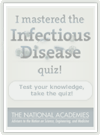
Place this badge on your Facebook page to show your friends what you know about infectious disease.
OR, get a higher score to unlock a different badge.
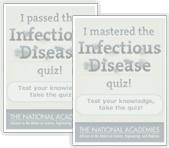
Explore Other Topics
Disease Watchlist
Infectious Disease Defined
- Gene
The physical and functional unit of heredity made up of DNA. Every individual has two copies of each gene, one inherited from the mother and the other from the father.
